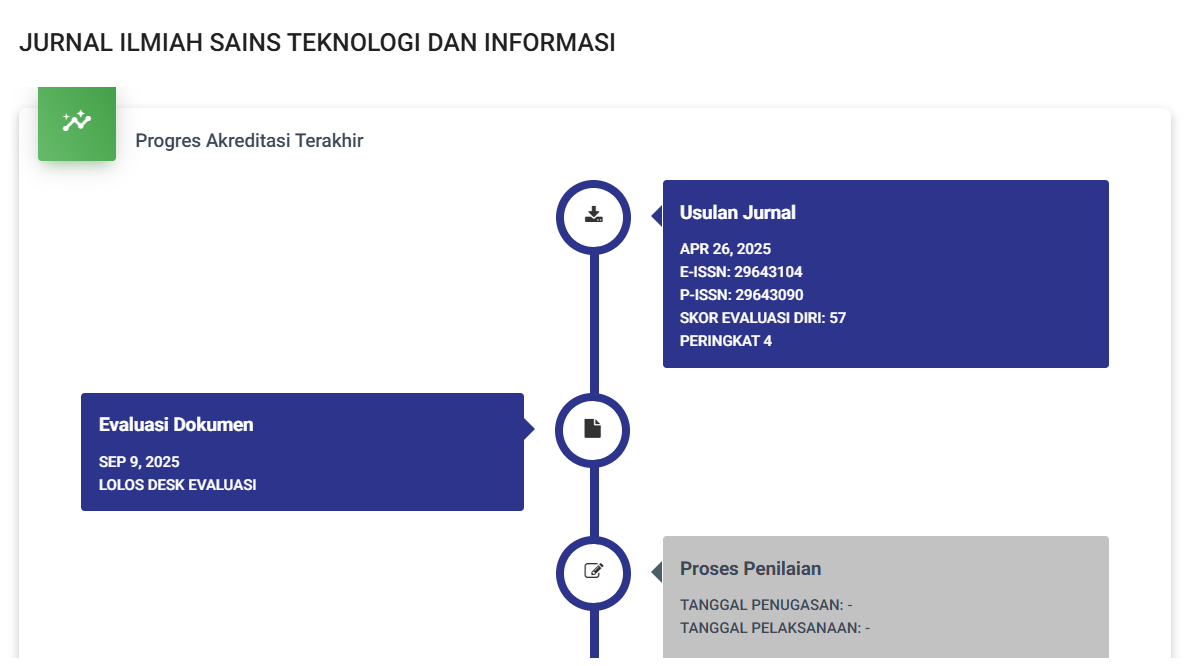PREDIKSI RISIKO DEMAM BERDARAH MENGGUNAKAN DECISION TREE BERDASARKAN GEJALA KLINIS DAN DATA LABORATORIUM
DOI:
https://doi.org/10.59024/jiti.v2i4.972Keywords:
Dengue Hemorrhagic Fever, Risk Prediction, Decision Tree, Clinical Symptoms, Laboratory Data.Abstract
Dengue Hemorrhagic Fever (DHF) is a disease caused by the Dengue virus and has a significant impact on public health, especially in tropical areas. Early diagnosis and prediction of DHF risk are essential to prevent complications and improve medical care. This study aims to develop a DHF risk prediction model using the Decision Tree method based on clinical symptoms and laboratory data. The data used include symptoms such as fever, joint pain, rash, and laboratory results such as platelet count and hematocrit. The Decision Tree model was chosen because of its ability to handle data with various variables and provide easy-to-understand interpretations. The research data were taken from patients diagnosed with DHF in several hospitals during a certain period. The dataset was then analyzed to find relevant patterns that could predict a high risk of DHF. The model training and testing process was carried out using cross-validation techniques to ensure prediction accuracy. The results showed that the Decision Tree model had an accuracy rate of 96.95% and consistent results from cross-validation which produced an average accuracy of 92.8%,, with good sensitivity and specificity in predicting DHF risk based on a combination of clinical symptoms and laboratory data. Factors such as low platelet count and fever symptoms lasting more than three days were found to be significant predictive variables. In conclusion, this Decision Tree model has the potential to be used as a tool in early prediction of DHF risk, which can help medical personnel in clinical decision making and patient management. Further development can be done by adding other variables such as epidemiological data to improve model performance.
References
G. Ginanjar, Demam berdarah. PT Mizan Publika, 2008.
H. Akbar and E. M. Syaputra, “Faktor risiko kejadian demam berdarah dengue (DBD) di Kabupaten Indramayu,” Media Publ. Promosi Kesehat. Indones., vol. 2, no. 3, pp. 159–164, 2019.
B. S. L. Anggoro and S. T. Aris Rakhmadi, “Sistem Pakar Diagnosa Penyakit Demam Berdarah Menggunakan Metode Decision Tree.” Universitas Muhammadiyah Surakarta, 2018.
A. Homaidi and Z. Fatah, “Implementasi Metode K-Nearest Neighbors (KNN) untuk Klasifikasi Penyakit Jantung,” G-Tech J. Teknol. Terap., vol. 8, no. 3, pp. 1720–1728, 2024.
A. I. Putri, Y. Syarif, P. Jayadi, F. Arrazak, and F. N. Salisah, “Implementasi Algoritma Decision Tree dan Support Vector Machine (SVM) untuk Prediksi Risiko Stunting pada Keluarga: Implementation of Decision Tree and Support Vector Machine (SVM) Algorithm for Stunting Risk Prediction,” MALCOM Indones. J. Mach. Learn. Comput. Sci., vol. 3, no. 2, pp. 349–357, 2023.
E. Nugraheni, D. Rizqoh, and M. Sundari, “Manifestasi Klinis Demam Berdarah Dengue (DBD),” J. Kedokt. Dan Kesehat. Publ. Ilm. Fak. Kedokt. Univ. Sriwij., vol. 10, no. 3, pp. 267–274, 2023.
J. Ginting, R. Ginting, and H. Hartono, “Deteksi Dan Prediksi Penyakit Diabetes Melitus Tipe 2 Menggunakan Machine Learning (Scooping Review),” J. Keperawatan Prior., vol. 5, no. 2, pp. 93–105, 2022.
M. F. Aditya, A. Pramuntadi, D. P. Wijaya, and Y. Wicaksono, “Implementasi Metode Decision Tree pada Prediksi Penyakit Diabetes Melitus Tipe 2: Implementation of Decision Tree Method for Diabetes Mellitus Type 2 Prediction,” MALCOM Indones. J. Mach. Learn. Comput. Sci., vol. 4, no. 3, pp. 1104–1110, 2024.
Z. Setiawan et al., Buku Ajar Data Mining. PT. Sonpedia Publishing Indonesia, 2023.
S. J. Rigatti, “Random forest,” J. Insur. Med., vol. 47, no. 1, pp. 31–39, 2017.
G. Varoquaux, L. Buitinck, G. Louppe, O. Grisel, F. Pedregosa, and A. Mueller, “Scikit-learn: Machine learning without learning the machinery,” GetMobile Mob. Comput. Commun., vol. 19, no. 1, pp. 29–33, 2015.
S. Dewi, “Komparasi 5 metode algoritma klasifikasi data mining pada prediksi keberhasilan pemasaran produk layanan perbankan,” J. Techno Nusa Mandiri, vol. 13, no. 1, pp. 60–65, 2016.
I. Harjanto, M. Amiruddin, and B. H. Kunaryo, “OPTIMASI MODEL DEEP LEARNING UNTUK RASPBERRY MENGGUNAKAN PRUNING DAN KUANTISASI,” J. Teknol. Inf. DAN Komun., vol. 15, no. 2, pp. 360–370, 2024.
Downloads
Published
Issue
Section
License
Copyright (c) 2024 JURNAL ILMIAH SAINS TEKNOLOGI DAN INFORMASI

This work is licensed under a Creative Commons Attribution-ShareAlike 4.0 International License.










